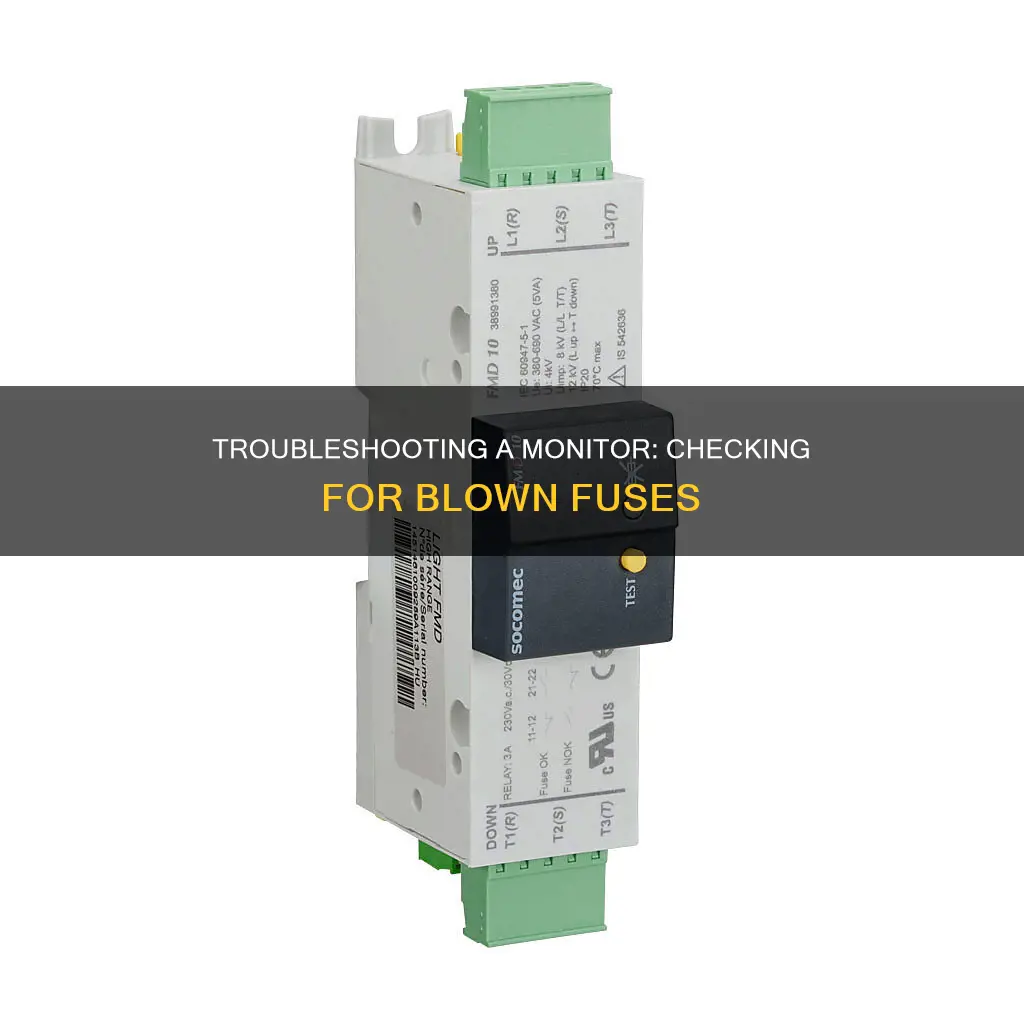
A blown fuse can be a frustrating and sometimes dangerous problem. Fuses are designed to protect electrical circuits from damage caused by excess current. However, if a fuse blows, it can cause the equipment to stop working or even pose a fire hazard. Luckily, there are several ways to identify a blown fuse.
One of the most straightforward ways to tell if a fuse is blown is to simply look at it. Blown fuses often exhibit visual indicators such as a broken or cracked filament or black or grey discolouration around it. Additionally, some blown fuses may have metallic residue inside the glass container.
If the fuse is not transparent or the indicators are not obvious, you can use a multimeter to test for a blown fuse. A multimeter measures voltage, electrical flow, and resistance. By connecting the multimeter to the fuse and observing the reading, you can determine whether the fuse is intact or blown.
Identifying a blown fuse is usually straightforward, and replacement fuses are typically inexpensive and easy to install. However, if you are unsure or the problem persists, it is always best to consult a licensed electrician to ensure a safe and effective resolution.
| Characteristics | Values |
|---|---|
| Visual signs | Broken filament, black or grey discolouration, cracked glass container |
| Non-visual signs | Short circuits, Ground faults, Damaged outlets or electrical wires, Overloaded circuit |
| Testing method | Multimeter |
What You'll Learn

How to identify a blown fuse in a glass container
A blown fuse can be a frustrating and sometimes dangerous problem. Fuses are designed to protect electrical circuits from damage caused by excess current. Identifying a blown fuse is usually straightforward. You can tell if a fuse is blown by inspecting the glass container for visible signs of damage. If the glass container is cracked or broken, it is likely that the fuse inside is blown. Additionally, some blown fuses will have a black or gray metallic residue running throughout the glass container.
If the fuse appears to be intact, you can test it with a multimeter, which measures voltage, electrical flow, and resistance. To do this, turn off any power leading to the circuit box and put on protective rubber gloves. Remove the fuse from the slot and set the multimeter to "continuity." Touch the positive and negative leads together and listen for a beep, indicating that the multimeter is functioning correctly. Then, place each lead on either end of the fuse. If the multimeter beeps continuously, the fuse is in good working order. If you don't hear anything or only hear sporadic beeping, the fuse is blown.
It is important to replace a blown fuse with a new one of the same type and rating to ensure the safety of your electrical system.
Enabling 165Hz on Your ASUS Monitor: A Step-by-Step Guide
You may want to see also

How to identify a blown fuse in a non-transparent body
It can be challenging to identify a blown fuse, especially when dealing with a non-transparent fuse body. Here are some detailed instructions to help you determine if a fuse is blown in such cases:
Visual Inspection:
- Start by locating your fuse box, typically found in the garage or basement.
- Open the fuse box and inspect the fuses. Look for any signs of physical damage, such as a cracked or broken glass container holding the fuse. Blown fuses may also exhibit metallic residue inside the glass container.
- Check if the filament inside the fuse is intact. A blown fuse typically has a broken filament and may show black or gray discoloration around it.
Non-Visual Signs:
- Short circuits, ground faults, damaged outlets, or electrical wires can indicate a blown fuse.
- An overloaded circuit could be another sign. If too many devices are plugged into a power strip or a specific appliance is heavily used, it can overload the circuit and blow the fuse.
- If a system or appliance suddenly stops working, it could be due to a blown fuse interrupting the power supply.
Testing with a Multimeter:
- If you're unsure or unable to determine the fuse's condition through visual inspection, you can use a multimeter to test for a blown fuse. A multimeter measures voltage, electrical flow, and resistance.
- Turn off any power leading to the circuit box from the main breaker for safety.
- Connect the black lead of the multimeter to the Common socket and the red lead to the Ohms (Ω) socket.
- Set the multimeter to the lowest range of the Ohms scale (200 ohms or 2 Megaohms). This should power on the meter.
- Touch the metal tips of the testing leads together, and ensure the meter display shows little to no resistance.
- Place the metal tips of the testing leads on each end of the fuse. It doesn't matter which lead touches which end of the fuse. Ensure good contact by touching a clean metal surface.
- Observe the multimeter reading. If it shows low resistance (similar to when the leads were touched together), the fuse is intact. If the display shows high resistance or no change, the fuse is likely blown.
Remember to exercise caution when dealing with electrical components. If you're uncertain or uncomfortable performing these steps, it's best to seek professional assistance from a qualified electrician.
The Acer LCD Monitor Ka240h: Are There Built-in Speakers?
You may want to see also

How to test a fuse with a multimeter
A fuse is a crucial safety device designed to protect electrical circuits from damage caused by excessive current. When a fuse blows, it cuts off the electricity supply, preventing further damage or hazards. Testing a fuse with a multimeter is a straightforward process, but it requires careful setup and execution to ensure accurate results and maintain safety. Here's a detailed guide on how to test a fuse with a multimeter:
Prepare the Multimeter:
- Ensure the power to the circuit is turned off.
- Set the multimeter to the continuity setting ("CONT" or the diode symbol). This mode checks for a complete path within the fuse.
Perform a Continuity Test:
- Remove the fuse from its holder to avoid false readings.
- Place the multimeter probes on both ends of the fuse. The probe placement order does not matter.
- Listen for a beep. If the multimeter beeps, it indicates continuity, meaning the fuse is intact and functional.
- Inspect the display. Some multimeters show a numerical value, with a high resistance value confirming a blown fuse.
Conduct a Resistance Test:
- Disconnect the fuse from any power source.
- Set the multimeter to measure resistance (often symbolized by the Greek letter Omega, Ω).
- Touch one probe to each end of the fuse, ensuring good contact with the metal caps.
- Read the resistance value. A good fuse typically shows very low resistance, close to zero ohms. A blown fuse will display infinite resistance or 'OL' (overload).
Perform a Voltage Test:
- Ensure it is safe to proceed with testing.
- Set the multimeter to measure voltage. Choose AC voltage if the fuse is on an AC circuit, and DC otherwise.
- Insert one probe into each terminal of the fuse holder, avoiding direct contact with metal probes.
- Check the voltage reading. A zero reading indicates a blown fuse, while a non-zero reading suggests the circuit is live and the fuse is intact.
By following these steps and interpreting the results correctly, you can effectively determine the status of a fuse and ensure the safety and functionality of your electrical systems.
Restarting Your ASUS Monitor: A Simple Guide
You may want to see also

How to identify a blown fuse without a multimeter
Identifying a blown fuse without a multimeter is relatively easy. Here are the steps you can follow:
Firstly, locate your fuse box, which is usually found in the garage or basement. Once you've found it, open it up and inspect the fuses. Look for any visible signs of damage, such as a cracked or broken glass container holding the fuse. Blown fuses may also exhibit metallic residue inside the glass container.
If you don't see any obvious signs of damage, the next step is to check for non-visual signs of a blown fuse. These include short circuits, ground faults, damaged outlets or electrical wires, and an overloaded circuit. A short circuit can cause sparks, smoke, or flames, and you may hear a crackling sound. Ground faults can cause strobing lines on a computer or television screen. Damaged outlets may exhibit burn marks, melting, chips, or cracks, and they may feel warm to the touch. For damaged wiring, listen for buzzing noises, look for dimming lights, and check for any discoloration or smoke. If your circuit is overloaded, simply unplug some devices or appliances and reset the circuit breaker.
If you suspect a blown fuse, the next step is to remove it from the fuse box and inspect it more closely. Look for a broken or darkened filament inside the fuse, which indicates that it has blown. You may also see black metallic residue inside, which is another sign of a blown fuse.
Finally, if you're still unsure, you can always replace the fuse with a new one of the same type and rating. This is a relatively inexpensive fix, and it may save you from more significant electrical issues down the line.
Monitors: Rapid Growth to Full Size, How Quick?
You may want to see also

What to do if you've identified a blown fuse
If you've identified a blown fuse, the first step is to unplug or turn off all devices and appliances connected to the affected circuit. This is important to avoid any potential hazards.
Next, you'll want to locate the fuse box and identify the blown fuse. If you're unsure how to identify a blown fuse, look for visual indicators such as a cracked or broken glass container, or metallic residue inside the container. You can also test for a blown fuse with a multimeter, which measures voltage, electrical flow, and resistance.
Once you've located the blown fuse, it's important to determine the reason for its failure. This could be due to an overloaded circuit, a short circuit, faulty wiring, a faulty appliance, power surges, old or worn-out fuses, or the incorrect fuse type.
After addressing the underlying problem, it's time to replace the blown fuse with a new one of the same type and rating. It's crucial to use the correct replacement to avoid safety hazards and future issues. Here's a step-by-step guide to replacing the fuse:
- Turn off the main power to the fuse box to prevent any danger of electric shock.
- Remove the blown fuse. Some fuses can be removed by hand, while others may require a small flat-head screwdriver.
- Take the blown fuse with you to the hardware store to ensure you get the correct replacement. If you're shopping online, make sure to double-check the size and voltage. It's a good idea to buy a few spares for future use.
- Screw the new fuse in by hand. It should fit securely into the holder without any resistance.
- Turn on the power to the fuse box. If you have a voltage tester, you can use it to check if power is running to the outlets connected to the newly replaced fuse.
- Plug your appliances and devices back in and turn them on. Do this gradually to avoid overwhelming the new fuse.
If the fuse blows again, it's best to consult a qualified electrician to identify and resolve the issue.
Troubleshooting ASUS Monitor: Flashing Issue
You may want to see also
Frequently asked questions
The most reliable way to identify a blown fuse is through a visual inspection. Look for signs of damage, such as a cracked or broken glass container, black or grey discolouration, or a broken filament inside the fuse.
Aside from visual cues, a blown fuse may manifest as a loss of power, devices or appliances not functioning, repeated tripping of a circuit breaker, or the need to frequently replace a specific fuse.
You can use a multimeter, which measures voltage, electrical flow, and resistance. First, turn off any power leading to the circuit box and put on protective gear, such as rubber gloves. Then, remove the fuse and set the multimeter to "continuity." If the multimeter beeps when the leads are connected, it is functioning. Place the leads on each end of the fuse; if it beeps continuously, the fuse is intact. If there is no beeping or only sporadic beeping, the fuse is blown.
First, turn off the power to the affected circuit and unplug or switch off any connected devices. Then, replace the blown fuse with a new one of the same type and rating. Finally, restore power to the circuit. If the issue persists or you are uncertain, consult a qualified electrician.







